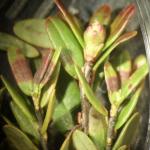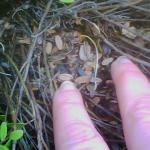With the many frosts and recent rains, many growers have not swept bogs nor have they treated. As soon as an opening appears, you should sweep your bog.
Winter moth is still tiny on cranberry but present on 1 in 10 bogs. If you are only picking up a few, let it go but if you are picking up over 10 per sweep set you should consider treating with Avaunt or Delegate. In the lab they clearly eat out cabbage heads and can do significant damage to this years crop.
If you have advanced vines (newer plantings or recently sanded areas) the winter moth larvae will advance more rapidly. One case with one inch growth had ¼" larvae that were webbing together uprights. Be sure to scout these bogs as damage could be significant. If you don't know what the winter moth larvae look like, look for holes in any blueberry or maple near the bog, many are infested with ¼" larvae!
Left Photo: Cabbage head in center, eaten out cabbage heads on left and right, result of winter moth larva feeding in the lab.
Right Photo: Advanced growth on new plantings have advanced winter moth larvae development and webbing evidence.
Black-headed fireworm has been found a ½ dozen bogs as of last week. Larvae are tiny but warrant scouting if you have a history of a problem. The first gypsy moth larvae have also been reported.
We had our first report of dodder seedling emergence on April 30th. You should be looking for emerged seedlings in warm areas or where you take off fruit. Often, you must part the vines and look in the duff for the seedling (see photo). Plan Casoron applications for 7-10 days after you see the early seedlings. QuinStar applications can go out preemergence to early postemergence.


